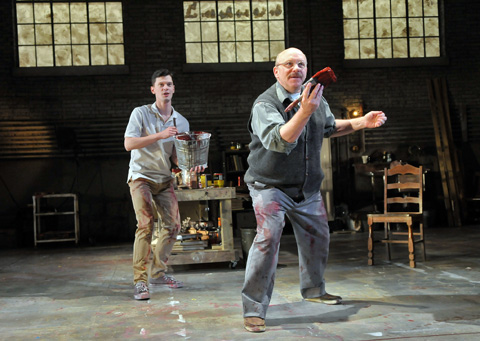
BATTLEFIELD In Ken Logan’s play about Mark Rothko (with Karl Baker Olson and Thomas Derrah), cliché is subsumed by volcanic passion. |
Mark Rothko sees red in Red — and not just when staring hard at his iconic Seagram murals. In dramatist/screenwriter John Logan's 2010 Tony-winning play about the volatile if depressive Abstract Expressionist, Rothko is bullshit about everything from a new assistant's not having read Nietzsche to the fat cats who buy his paintings to match their furniture or plump up their portfolios. And in the expertly executed Boston premiere by SpeakEasy Stage Company (at the Calderwood Pavilion through February 4), Thomas Derrah is a shlumpy, sweater-vested, paint-spattered Vesuvius of anger, arrogance, pain, and pontification about art. Rothko is considered a pioneer of Color Field painting; here it's color battlefield painting.Red is set in 1958 and 1959 in the 50-something artist's looming, grubby studio in the Bowery (well conceived by set designer Cristina Todesco and moodily lit by Jeff Adelberg so that even the filthy windows glow). The opening finds a silhouetted Rothko alone with the paintings he considers both self-abnegation and children. But having accepted a hefty commission for a series of murals to decorate the Four Seasons restaurant in the new Seagram Building on Park Avenue, this bourgeoisie-hating son of Russian immigrants has hired a new assistant. The fictional Ken is an aspiring painter who will agree to take the vows of self-abasement, abuse-acceptance, and going-for-coffee that Rothko requires. Despite the testy-if-titanic artist's initial roar that he is neither Ken's rabbi, father, shrink, nor friend, this sets up a Socratic dialogue that is about art but also about the cruel necessity of eating not only one's young but one's sires. Logan's play is not without mentor-student clichés (and the quiet Ken has to have a backstory that literalizes the tragedy Rothko perceives in his own paintings), but it brims with enough volcanic passion and insight to trump those faults.
Rothko likes to imagine his large, contemplative paintings presiding over a temple, and David R. Gammons's production evokes not only a scene of carnage but also a church, with its incomplete Rothko facsimiles serving as tapestries. The set is a vast if utilitarian jumble, and Bill Barclay's propelling sound design combines Rothko's preferred classical tunes with the woomph-and-clang of industrial sound. In one scene, Rothko and Ken prime a canvas, applying thick wine-colored pigment with housepainter's brushes, their workout timed to climactic classical strains. So we don't just hear art jawed about; we get to experience the sometime ferocity of making it.
Mostly though, Rothko seethes and bloviates, preparing to paint as he tutors Ken in the art of what that takes and what it takes out of you. Not that he pays much attention to Ken as he's doing it. The painter's egotism, in fact, is so naked it's funny. And Derrah mines considerable comedy from his shortish, larger-than-life megalomaniac, whose ardor (for Matisse's The Red Studio, for example) and impatient distastes (for the Pop artists at his heels) are so intense that they're more disarming than obnoxious. And as the younger man, a contained if not cowed Karl Baker Olson is still water revving up for a splash as he counters Rothko's visceral connection to art with an eager analysis of the Apollonian and Dionysian doing battle amid Jackson Pollock's drips and Rothko's pulsing layers.
 Topics
Topics:
Theater
, SpeakEasy Stage Company, Theater, Arts, More  , SpeakEasy Stage Company, Theater, Arts, Mark Rothko, red, Less
, SpeakEasy Stage Company, Theater, Arts, Mark Rothko, red, Less 